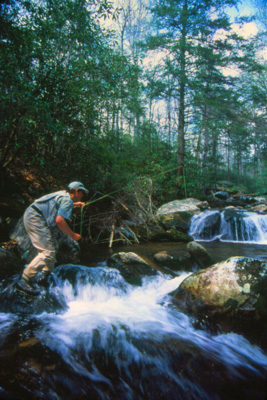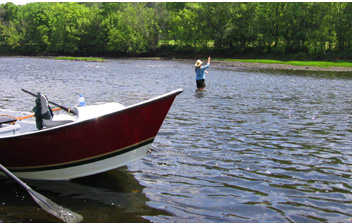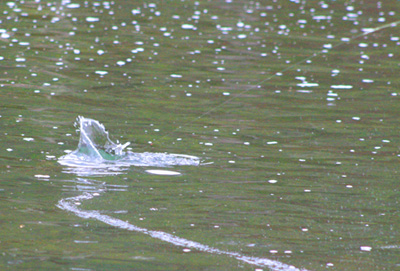Many fly fishers put the importance of the fly above all, but there are several factors that are far more important than fly selection. These are exceptionally easy to accomplish, but not practiced as often as they should.
As fly fishers we have an advantage over natural predators like osprey, herons, water snakes, and otters. They have to catch their dinner with their claws and mouths. Skilled anglers fool trout into coming willing to a fly. All too often many anglers negate the advantages of a well tied fly and clear monofilament leader.
Put the fly where a fish will see it. This is a relatively simple concept, but one that is often overlooked. A fly fisher may have the best fly ever devised, but it is worthless if a fish never sees it. Anglers should strive to find the best spots to cast a fly. Feeding lanes are always the best place to cast a fly since these are the currents where fish find food most often. Most trout will not be found in excessively swift water or still water. Swift water requires a good deal of energy to hold in and still water doesn’t have enough current to bring a steady supply of food.

There's a lot of water out there and that fly is small. Be sure to put it where a fish can see it.
Take special care not to spook fish or make them aware of your presence. As soon as a fish has spooked you will not catch him. This is basic knowledge, but we often see anglers on the river who seem to ignore this fact. We have even watched some anglers wade through pods of rising fish to get a better casting position. Of course this better casting position was worthless once the fish were gone! If a fish runs away to hide it will never see your fly. Again, the perfect fly has been rendered useless.

Move slowly on the water and cast from a position where trout won't notice you.
Make accuracy a priority over distance when casting the fly. The ability to cast a fly far is a valuable skill, but that skill is nullified if you can’t hit a target. Even when casting from a drift boat a 30 foot cast usually works better than a 60 or 70 foot cast. Many anglers can hit a target at 30 feet but have more difficulty as the distance grows. Again, trout will not see your fly if it lands off target.
We often fish to pods of midging fish on our local tailwaters here in East Tennessee. The midge hatches are so prolific that most fish will not move more than a couple of inches for such a small offering. Casting accuracy is crucial in this situation where being off by about a foot might be about as effective as missing by a mile.
Ensure your accuracy by stacking the odds in your favor and only make casts that have at least a reasonable shot of hitting the target. Long casts also increase the chances of a sloppy cast that slaps the water and spooks the fish.

Short casts are usually better than long casts even when fishing from a drift boat.
Get a good drift so the fly looks natural on the water. Ever heard the old adage that good looks will only get you so far? That’s particularly true with trout flies. Even the most realistically tied fly will not look right to a trout if it drags across the current like a water skier. Anglers can do several things to make a good drift easier to accomplish. We’ve already mentioned shorter casts but shorter drifts are just as important. It is far easier to make a fly drift without drag for five or six feet than it is for 20 or 30 feet. Divide a run of water into several short drifts and you will increase your odds of covering a fish with a perfect drift. Another thing anglers can do is to plan ahead by anticipating drag and make the appropriate mend with the line before drag sets in. Mending line is less effective after drag has set in.
Give every drift a chance. We all make bad casts, but leave the fly on the water and see what happens. Worst case scenario a fish will not see the fly and you can pick it up and re-cast in a moment. Every season we see fly fishers pick up “bad casts” just as a fish was about to eat the fly. The fly was good enough to fool the fish, but the cast wasn’t good enough for the angler and he took it away when the fish wanted it. Let the fish be the judge and give every drift a chance, even if it didn’t meet your standard.
Dropping a fly to the water then picking it up quickly may also spook fish. Let the drift out of the zone you’re fishing. Even when fish want the fly they are less likely to come to it a second time if you picked it up before they got to it.

You've fooled the fish. Don't squander the opportunity!
Expect the strike. After reading the water, making an accurate cast, and getting a good drift it’s a real shame when you fool a fish but miss the strike. It never fails to surprise us when anglers say that they didn’t expect a fish to eat. Our response is, “Then why did you put the fly there?” There is no reason to make a cast if you don’t believe a fish might eat your fly.
Even when the fisherman had the perfect fly and the perfect drift he didn’t catch the fish because he was caught off guard. Our motto is “Be surprised when a fish didn’t come to the fly.” Act deliberately and have confidence in your cast and your drift. Try to anticipate the strike and be prepared for it.
